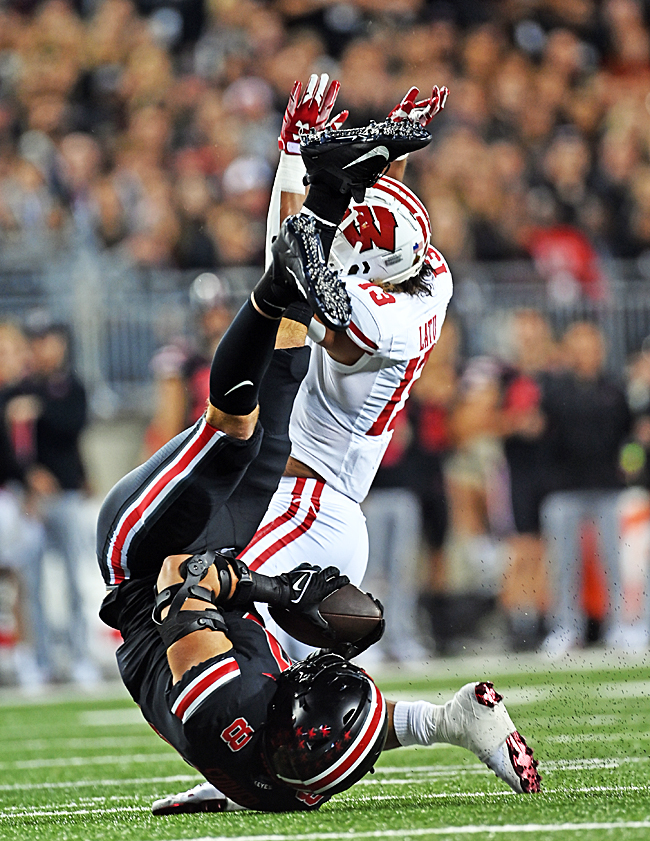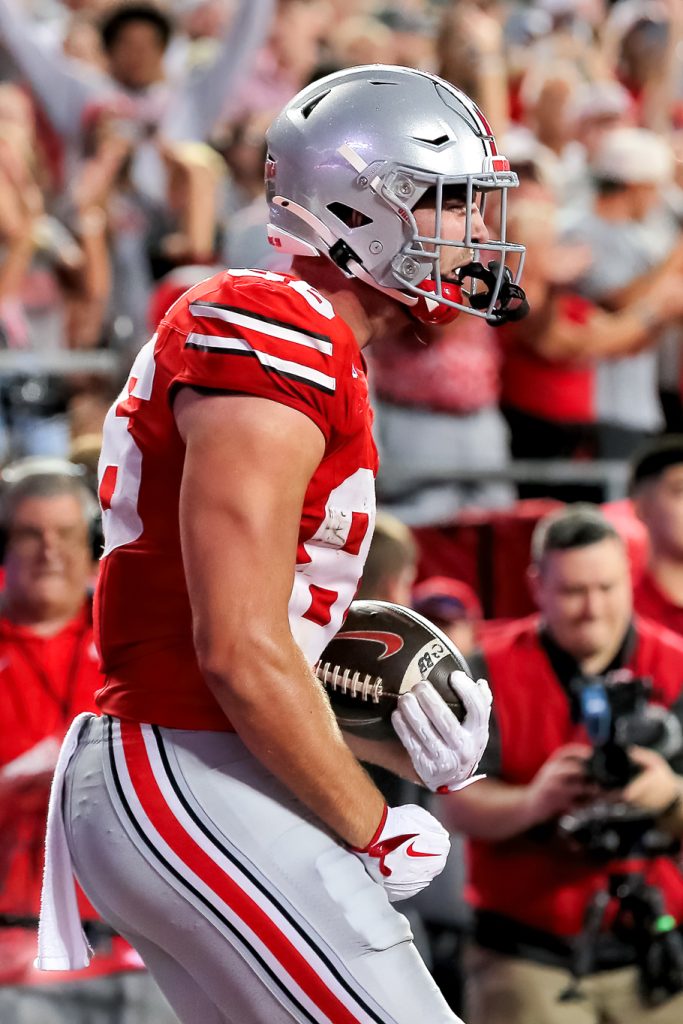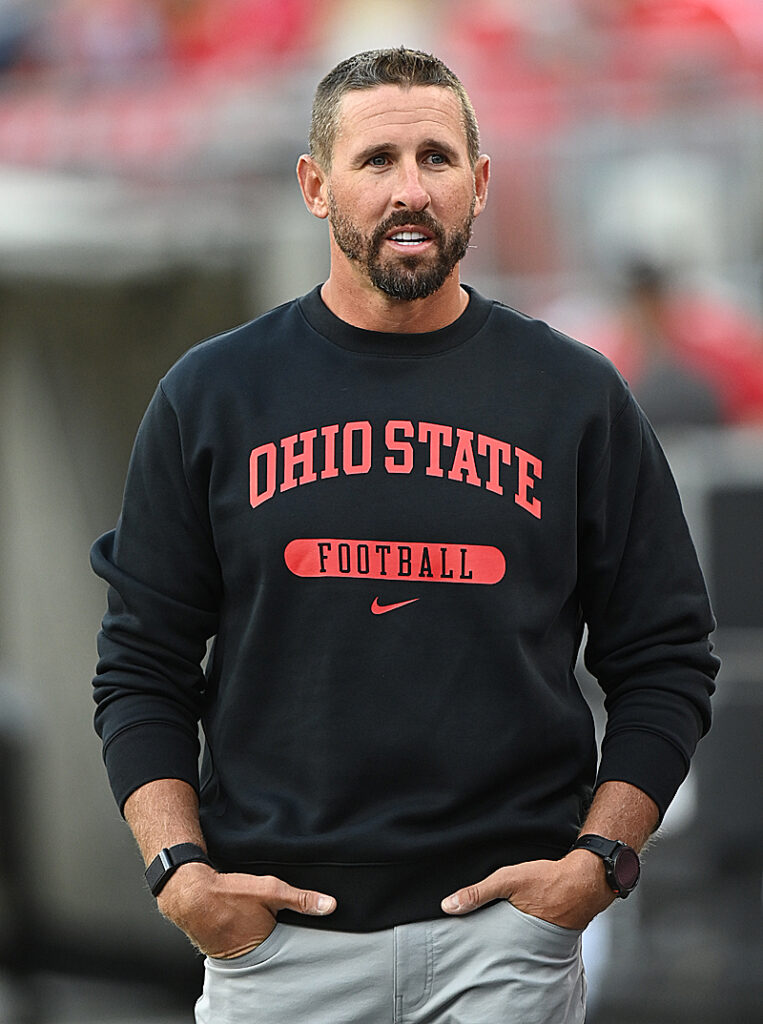
No one played the position with more passion, or popularity, than former Buckeye Cade Stover (above), now with the NFL Houston Texans. (Press Pros Feature Photo by Sonny Fulks)
On an off-weekend where reflection is all there is to write about, Ryan Day explains why tight end usage is on the rise for the Buckeyes: “We always try to stay a step ahead.”
By Marcus Hartman for Press Pros
 Columbus, OH — In case you missed it, the tight end is back at Ohio State, tasking opponents with more formations, options and tempos to prepare for.
Columbus, OH — In case you missed it, the tight end is back at Ohio State, tasking opponents with more formations, options and tempos to prepare for.
Was tight end ever really important here? Yeah, but not so much in my lifetime. Your mileage may vary.

Minster Bank proudly sponsors the best area sports coverage on Press Pros Magazine.com.
Cade Stover not only became the first Buckeye to be named Big Ten Tight End of the Year (an award that began in 2011) two years ago, he was also the first to catch more than 60 passes in his Ohio State career since Cedric Saunders in the early 1990s.

Veteran columnist Marcus Hartman writes the OHSAA, Ohio State, and sports at large for Press Pros Magazine.com.
Stover finished with 82 career receptions, No. 2 in the OSU career list but far short of John Frank’s record of 121 set from 1980-83.
Stover is the only player from the 21st Century near the top of the list most recently published by Ohio State, joining No. 3 John Ellis (1987-89), Saunders (1990-93), Bruce Jankowski (who was actually a split end from 1968-70 and should not be on this list) and Jan White (also 1968-70). Nick Vannett (2012-15) and Marcus Baugh (2014-17) round out the career top 10 with 55 catches.
Two reasons exist for the following predominant question about the tight ends every August I’ve been on the beat: “Are they going to catch many passes this season?”
1) We often focus too much on stats, and 2) They didn’t catch many passes in the offenses of Jim Tressel or Urban Meyer.
One wouldn’t have figured they would catch many — maybe less??? — in Ryan Day’s Ohio State offense (begun as Meyer’s version but with more passing). But that doesn’t mean the position wasn’t important. When he was the offensive coordinator and tight ends coach, Kevin Wilson waxed poetically once or twice a year about how much of the offense revolved around the tight end, whose role was half left tackle, half wide receiver.
And yet they had to scrape most years to find one game-ready tight end, let alone two. That seemed to be because the head coach and/or recruiting coordinator refused to devote enough roster spots to have much hope for having depth.
Well, 2025 is a different time.
Will Kacmarek arrived via the transfer portal from Ohio University before last season with the reputation of blocker first. He played an important enough role opposite starter Gee Scott Jr. When Kacmarek was hurt, they relied more on Bennett Christian rather than abandoning a two tight-end set known as 12 personnel (one running back, two tight ends, two receivers).
The 12 set is a departure from the Meyer era when the base formation was 11 with one back, one tight end and three receivers. That trend continued with Day. The lack of tight end recruiting didn’t leave him much choice.
Scott graduated, but Kacmarek and Christian are back. They’ve been joined by Max Klare, a pass-catching tight end who transferred from Purdue, and that’s not all. Jelanie Thurman’s role has increased in his third season. Even freshman Nate Roberts has been used at fullback in the first three games.

Purdue transfer Max Klare scored his first touchdown as a Buckeye in last week’s win over Ohio University. (Press Pros Feature Photo by Brian Bayless)
So what gives? Why the shift to putting two, three (13 personnel) or even four (14 personnel) tight ends on the field together?
“Well, this started a couple years ago,” Day said recently. “When you just stay in 11 (personnel), there are ways that teams schematically can defend you. If you’re just exclusively one thing after a while — this is what I try to tell the coaches all the time — they’re going to get you eventually.”
That means three-receiver sets have diminishing returns, even at a place that recruits receivers like Ohio State.
“We’ve been 11 around here for a long time, so the ability to jump into 12 and 13 personnel gives us something different,” Day said. “It’s a change-up.”
But there is more to it than swapping a big guy for a little guy. Day also sees value in switching between playing fast (using tempo) and slow. Therefore, he requires tight ends to catch and receivers to block. Keep the defense on its heels and guessing.
“In my opinion, when a defensive player goes from 11 to 12 to 13 back to 11 to tempo to empty, and all these different things come into play, it’s harder for them to nail down exactly what you’re doing,” Day said. “If you’re always in 11, you’re always in one tempo, it’s a lot easier for them to kind of zero in on what you’re doing. So we want to put as much stress (as we can). We’ve always felt that way. And as the game has evolved year in and year out, we try to stay a step ahead.”

The Precision Strip Company, in Minster and Troy, proudly sponsors the best high school sports coverage on Press Pros.
That’s why a couple years ago a deeper commitment was made to broader skill sets: multiple tight ends who can also catch passes and wide receivers who can also block.
“If you’re just doing one thing, that’s no good,” Day said. “Teams can start to narrow in on what you can do, and then they start to really dive into what they’re going to get when you’re in the game. So the more versatility your guys have, the better.”
To reach this point of roster strength for versatile tight ends, Day had to bring in more bodies and make sure his staff was doing all it can to develop the ones they had.

“Putting those guys in the right position can be a bonus for the offense, but you got to use them properly.” – Offensive coordinator Brian Hartline (Press pros Feature Photos)
“What you do is you take a look at what you have on the team that year and you build it around those guys,” he said. “We’ve always wanted to utilize our tight ends, and we’ve had some really good tight ends that have come. But now we probably are deeper there than we’ve been in the past.”
That created a great opening for the tight ends to be a stabilizing force, but how long will it last?
Perhaps they are back to stay.
Ohio State still has lots of talented receivers, but the offensive tackles are new, the quarterback is a redshirt freshman, and the running backs are still finding their footing, too.
That’s why Brian Hartline, a wide receiver from the Tressel era when throwing to the tight ends became an afterthought, is a believer in leaning on the big fellas in his first season as the team’s play-caller.
“Putting those guys in the right position can be a bonus for the offense, but you got to use them properly,” Hartline said, citing matching them up as a blocker on a safety or in a pass route against a linebacker as examples. “But they’ve done a really good job. They do a great job at practice. So ultimately for them to be worked in the game, I think is really, really important.”
If you want to buy stock in the Ohio State tight end room, it’s not too late.


